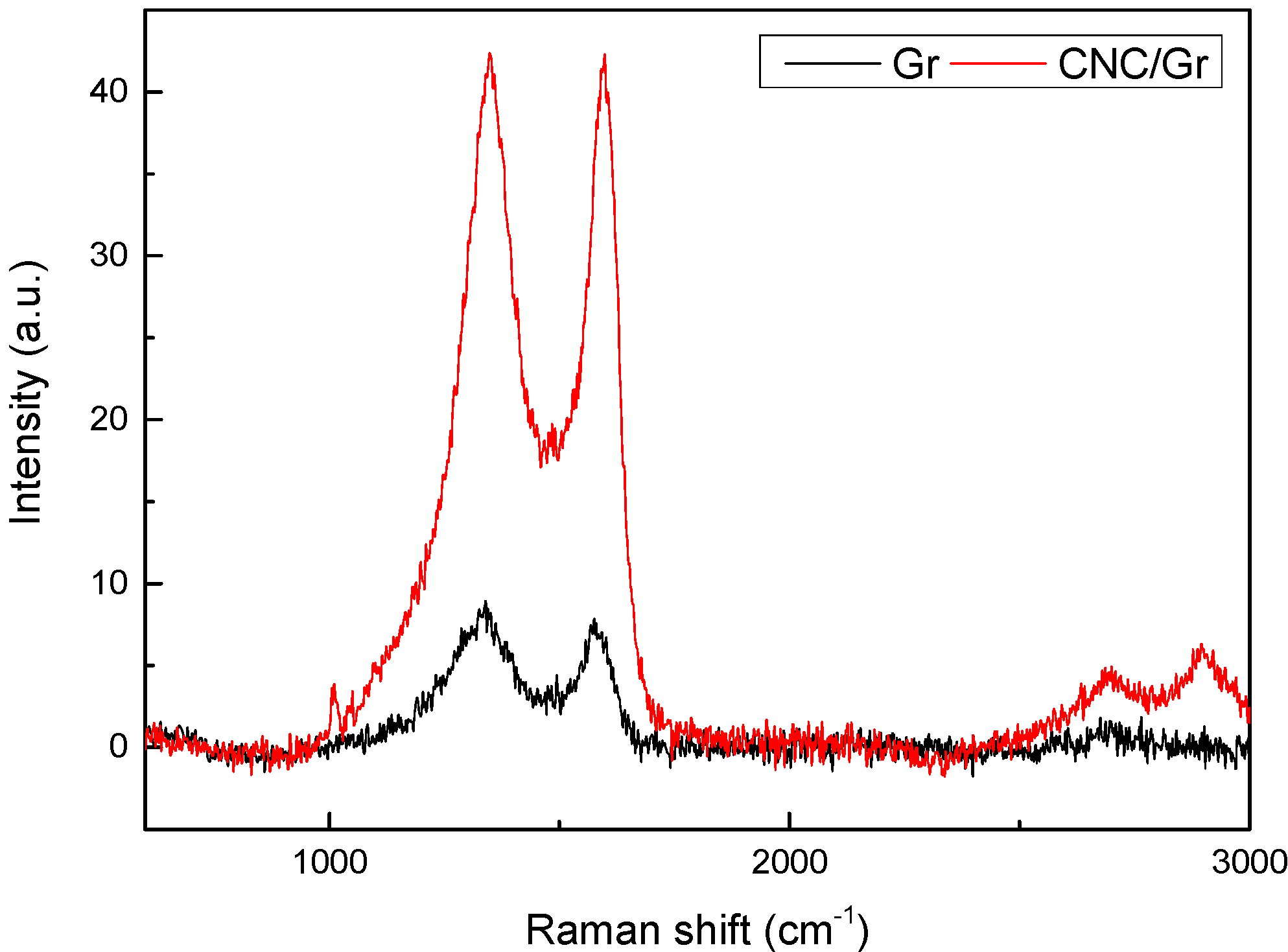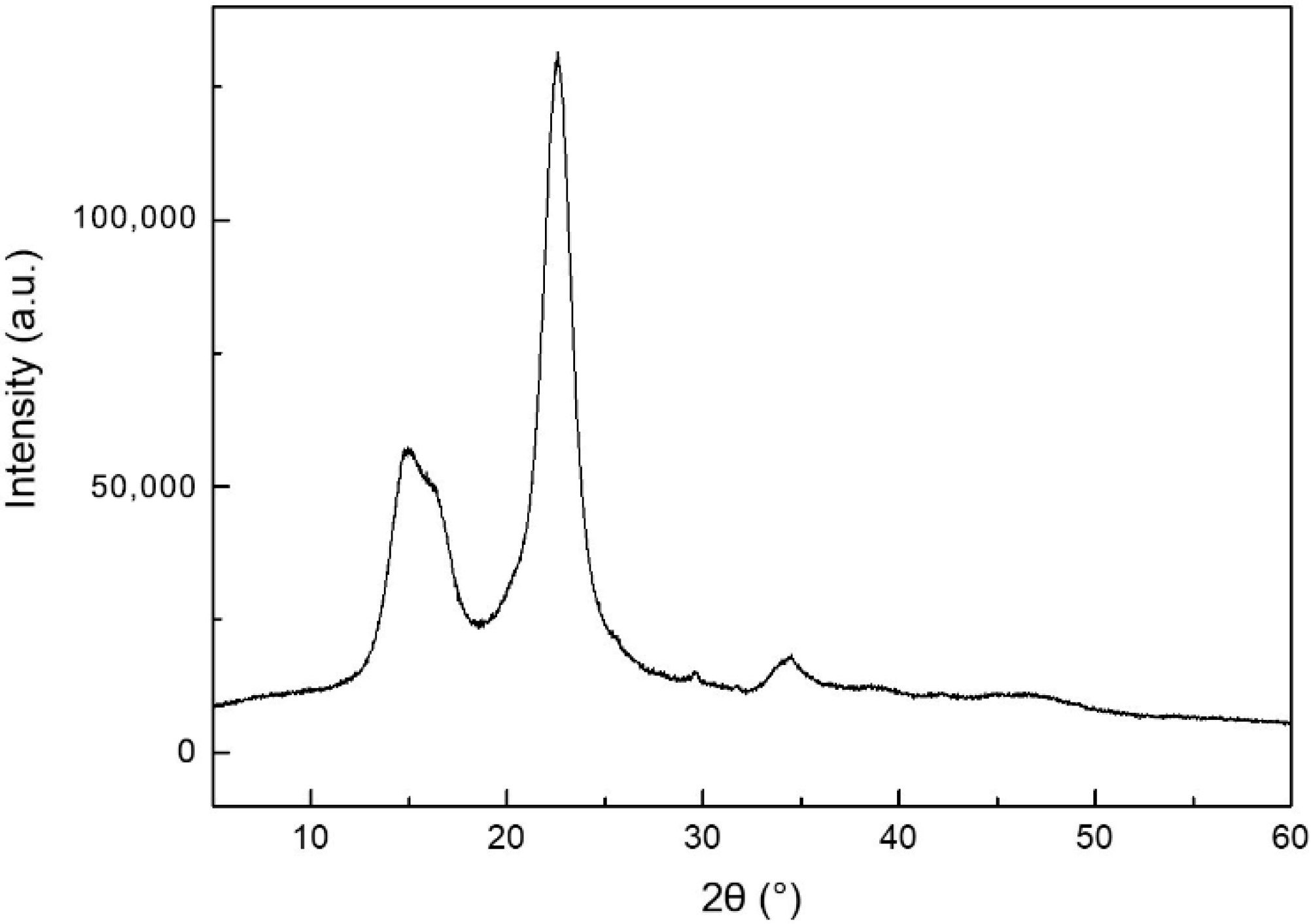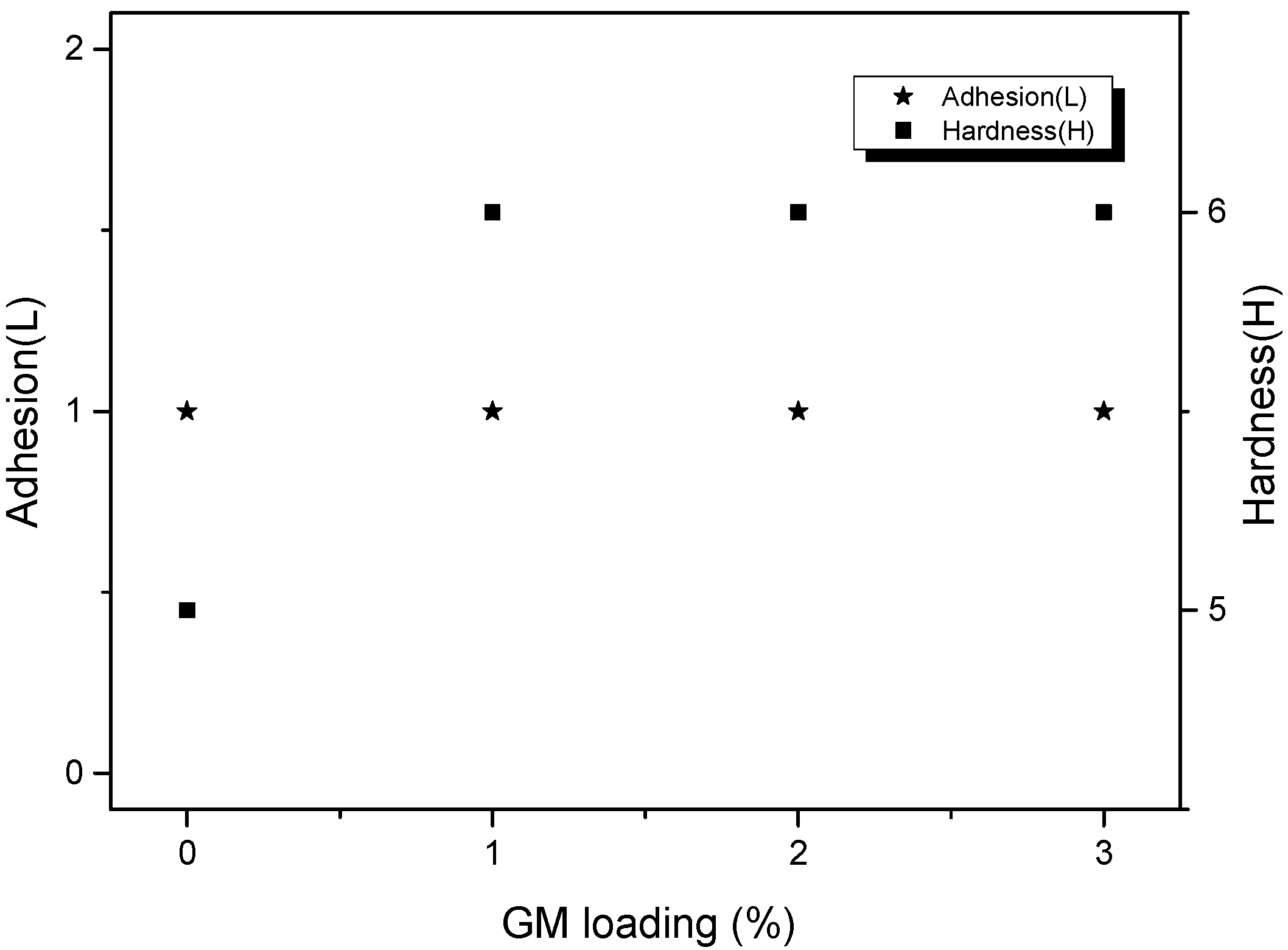Mechanical and Thermal Properties of Waterborne Polyurethane Coating Modified through One-Step Cellulose Nanocrystals/Graphene Materials Sols Method
Abstract
1. Introduction
2. Experimental
2.1. Materials
2.2. Preparation of CNC/GMsol Mixture through One-Step Method
2.3. Preparation of CNC/GM/2K-WPU Coating Samples
2.4. Characterizations
2.4.1. CNC/GM Sols
2.4.2. CNC/GM/2K-WPU Coating
3. Results and Discussion
3.1. Properties of CNC/GM Sols
3.1.1. Absorbance Analysis
3.1.2. FT-IR Spectra Analysis
3.1.3. Raman Spectrum Analysis
3.1.4. XRD Analysis
3.1.5. TEM Analysis
3.2. Mechanical Properties of CNC/GM/2K-WPU Coatings
3.2.1. Adhesion and Hardness
3.2.2. Abrasion Resistances
3.3. Thermal Properties of CNC/GM/2K-WPU Coatings
3.3.1. Thermal Stability
3.3.2. Thermal Conductivity
4. Conclusions
Author Contributions
Funding
Acknowledgments
Conflicts of Interest
References
- Aqdas, N.; Khalid, M.Z.; Mohammad, Z. Recent trends in environmentally friendly water-borne polyurethane coatings: A review. Korean J. Chem. Eng. 2015, 33, 1–13. [Google Scholar] [CrossRef]
- Dai, J.Y.; Ma, S.Q.; Liu, X.Q. Synthesis of bio-based unsaturated polyester resins and their application in waterborne UV-curable coatings. Prog. Org. Coat. 2015, 78, 49–54. [Google Scholar] [CrossRef]
- Wu, Y.; Sun, Y.C.; Yang, F.; Zhang, H.Q.; Wang, Y.J. The implication of benzene-ethanol extractive on mechanical properties of waterborne coating and wood cell wall by nanoindentation. Coatings 2019, 9, 449. [Google Scholar] [CrossRef]
- Wu, Y.; Wu, J.M.; Wang, S.Q.; Feng, X.H.; Chen, H.; Tang, Q.W.; Zhang, H.Q. Measurement of mechanical properties of multilayer waterborne coatings on wood by nanoindentation. Holzforschung 2019, 73, 1–7. [Google Scholar] [CrossRef]
- Palomares, E.; Clifford, J.N.; Haque, S.A.; Lutz, T.; Durrant, J.R. Control of charge recombination dynamics in dye sensitized solar cells by the use of conformably deposited metal oxide blocking layers. J. Am. Chem. Soc. 2016, 125, 475–482. [Google Scholar] [CrossRef] [PubMed]
- Sangermano, M.; Naguib, M.; Messori, M. Fracture toughness enhancement of UV-cured epoxy coatings containing Al. Macromol. Mater. Eng. 2013, 298. [Google Scholar] [CrossRef]
- Qiu, F.; Xu, H.; Wang, Y.; Yang, D. Preparation, characterization and properties of UV-curable waterborne polyurethane acrylate/SiO2 coating. J. Coat. Technol. Res. 2012, 9, 503–514. [Google Scholar] [CrossRef]
- Zhang, F.; Yang, W.; Pang, A.; Wu, Z.; Qi, H.; Yao, J.; Fan, Z.; Shao, J. Annealing effects on the optical and structural properties of Al2O3/SiO2 films as uv antireflection coatings on 4H-SiC substrates. Appl. Surf. Sci. 2008, 254, 6410–6415. [Google Scholar] [CrossRef]
- Samyn, P.; Stanssens, D.; Paredes, A.; Becker, G. Performance of organic nanoparticle coatings for hydrophobization of hardwood surfaces. J. Coat. Technol. Res. 2014, 11, 461–471. [Google Scholar] [CrossRef]
- Li, S.C.; Wang, L.W.; Wang, J.Y. Study on Properties of modified nano-ZnO/WPU hybrid material. Adv. Mater. Res. 2012, 510, 742–746. [Google Scholar] [CrossRef]
- Crespo-Soler, A.; Lardies-Miaza, N. Effect of nanosilica and ZnO nanoparticles on abrasion and uv resistance of waterborne polyurethane coating. Farby I Lakiery 2014, 5, 3–10. [Google Scholar]
- Sanderson, P.; Delgadosaborit, J.M.; Harrison, R.M. A review of chemical and physical characterisation of atmospheric metallic nanoparticles. Atmos. Environ. 2014, 94, 353–365. [Google Scholar] [CrossRef]
- Palimi, M.J.; Rostami, M.; Mahdavian, M.; Ramezanzadeh, B. Studying the effects of surface modification of Cr2O3 nanoparticles by 3-aminopropyltrimethoxysilane (APTMS) on its corrosion inhibitive performance. J. Sol-Gel Sci. Technol. 2015, 73, 141–153. [Google Scholar] [CrossRef]
- Chang, T.; Cao, X.; Li, N.; Long, S.; Jin, P. Facile and low-temperature fabrication of thermochromic Cr2O3/VO2 smart coatings: Enhanced solar modulation ability, high luminous transmittance and uv-shielding function. ACS Appl. Mater. Interfaces 2017, 9, 26029–26037. [Google Scholar] [CrossRef]
- Qian, B.; Song, Z.W.; Hao, L.; Fan, H.Q. Entrapment of polyaspartic acid on silica nanoparticle for self-healing coatings. Mater. Corros. 2017, 68, 717–724. [Google Scholar] [CrossRef]
- Habibi, Y.; Lucia, L.A.; Rojas, O.J. Cellulose nanocrystals: Chemistry, self-assembly, and applications. Chem. Rev. 2010, 110, 3479–3500. [Google Scholar] [CrossRef]
- Favier, V.; Chanzy, H.; Cavaille, J.Y. Polymer nanocomposites reinforced by cellulose whiskers. Macromolecules 1995, 28, 6365–6367. [Google Scholar] [CrossRef]
- Buffa, J.M.; Casado, U.; Mucci, V.; Aranguren, M.I. Cellulose nanocrystals in aqueous suspensions: Rheology of lyotropic chiral liquid crystals. Cellulose 2019, 26, 2317–2332. [Google Scholar] [CrossRef]
- Lemaster, R.L.; Lu, L.; Jackson, S. The use of process monitoring techniques on a CNC wood router. part 1. sensor selection. For. Prod. J. 2000, 50, 31. [Google Scholar]
- Huang, C.; Su, Y.; Shi, J.; Yuang, C.; Zhai, S.; Yong, Q. Revealing the effects of centuries ageing on the chemically structural features of lignin in archaeological fir woods. New J. Chem. 2019, 43, 3520–3528. [Google Scholar] [CrossRef]
- Lu, Q.; Lin, W.; Tang, L.; Wang, S.; Chen, X.; Huang, B. A mechanochemical approach to manufacturing bamboo cellulose nanocrystals. J. Mater. Sci. 2015, 50, 611–619. [Google Scholar] [CrossRef]
- Lin, W.; Chen, D.; Yong, Q.; Huang, C.; Huang, S. Improving enzymatic hydrolysis of acid-pretreated bamboo residues using amphiphilic surfactant derived from dehydroabietic acid. Bioresour. Technol. 2019, 293, 122055. [Google Scholar] [CrossRef] [PubMed]
- Huang, C.; Wang, X.; Liang, C.; Jiang, X.; Yang, G.; Xu, J.; Yong, Q. A sustainable process for procuring biologically active fractions of high-purity xylooligosaccharides and water-soluble lignin from Moso bamboo prehydrolyzate. Biotechnol. Biofuels 2019, 12, 189. [Google Scholar] [CrossRef] [PubMed]
- Wang, X.; Song, L.; Cheng, D.; Liang, X.; Xu, B. Effects of saturated steam pretreatment on the drying quality of moso bamboo culms. Eur. J. Wood Wood Prod. 2019, 77, 949–951. [Google Scholar] [CrossRef]
- Csiszár, E.; Nagy, S. A comparative study on cellulose nanocrystals extracted from bleached cotton and flax and used for casting films with glycerol and sorbitol plasticisers. Carbohydr. Polym. 2017, 174, 740–749. [Google Scholar] [CrossRef]
- Gao, T.; Yang, Z.; Chen, C.; Li, Y.; Fu, K.; Dai, J.; Hitz, E.M.; Xie, H.; Liu, B.; Song, J. Three-dimensional printed thermal regulation textiles. ACS Nano 2017, 11, 11513–11520. [Google Scholar] [CrossRef]
- Luzi, F.; Fortunati, E.; Jiménez, A.; Puglia, D.; Pezzolla, D.; Gigliotti, G.; Kenny, J.M.; Chiralt, A.; Torre, L. Production and characterization of PLA_PBS biodegradable blends reinforced with cellulose nanocrystals extracted from hemp fibres. Ind. Crop. Prod. 2016, 93, 276–289. [Google Scholar] [CrossRef]
- Zhu, Y.P.; Wang, M.; Xiang, Y.; Qiu, L.; Hu, S.; Zhang, Z.; Mattjus, P.; Zhu, X.; Zhang, Y. Nach is a novel subgroup at an early evolutionary stage of the CNC-BZIP subfamily transcription factors from the marine bacteria to humans. Int. J. Mol. Sci. 2018, 19, 2927. [Google Scholar] [CrossRef]
- Leston, S.; Nebot, C.; Nunes, M.; Cepeda, A.; Ramos, F. Sulfathiazole: Analytical methods for quantification in seawater and macroalgae. Environ. Toxicol. Pharmacol. 2015, 39, 77–84. [Google Scholar] [CrossRef]
- Huang, C.; Sun, R.; Chang, H.M.; Yong, Q.; Jameel, H.; Phillips, R. Production of dissolving grade pulp from tobacco stalk through SO2-ethanol-water fractionation, alkaline extraction, and bleaching processes. BioResources 2019, 14, 5544–5558. [Google Scholar]
- Wu, Y.; Tang, Q.W.; Yang, F.; Xu, L.; Wang, X.H.; Zhang, J.L. Mechanical and thermal properties of rice straw cellulose nanofibrils-enhanced polyvinyl alcohol films using freezing and-thawing cycle method. Cellulose 2019, 26, 3193–3204. [Google Scholar] [CrossRef]
- Pei, A.; Qi, Z.; Berglund, L.A. Functionalized cellulose nanocrystals as biobased nucleation agents in poly(l-lactide) (PLLA)-Crystallization and mechanical property effects. Compos. Sci. Technol. 2010, 70, 815–821. [Google Scholar] [CrossRef]
- Rao, A.; Divoux, T.; Mckinley, G.H.; Hart, A.J. Shear melting and recovery of crosslinkable cellulose nanocrystal-polymer gels. Soft Matter 2019, 15, 4401–4412. [Google Scholar] [CrossRef] [PubMed]
- Kargarzadeh, H.; Mariano, M.; Huang, J.; Ling, N.; Ahmad, I.; Dufresne, A.; Thomas, S. Recent developments on nanocellulose reinforced polymer nanocomposites: A review. Polymer 2017, 132, 368–393. [Google Scholar] [CrossRef]
- Yue, P.; Wang, S.; Li, X.; Ge, M. Preparation of polyaniline/Ag composite conductive fabric via one-step oxidation-reduction reaction. J. Text. Res. 2014, 60, 33–42. [Google Scholar]
- Yu, S.; Park, B.I.; Park, C.; Hong, S.M.; Han, T.H.; Koo, C.M. RTA-treated carbon fiber/copper core/shell hybrid for thermally conductive composites. ACS Appl. Mater. Interfaces 2014, 6, 7498–7503. [Google Scholar] [CrossRef]
- Mengal, N.; Sahito, I.A.; Arbab, A.A.; Sun, K.C.; Qadir, M.B.; Memon, A.A. Fabrication of a flexible and conductive lyocell fabric decorated with graphene nanosheets as a stable electrode material. Carbohydr. Polym. 2016, 152, 19–25. [Google Scholar] [CrossRef]
- Gan, L.; Shang, S.; Yuen, C.W.M.; Jiang, S.X. Graphene nanoribbon coated flexible and conductive cotton fabric. Compos. Sci. Technol. 2015, 117, 208–214. [Google Scholar] [CrossRef]
- Tang, B.H.G.; Gao, H.; Hai, L. Application of graphene as filler to improve thermal transport property of epoxy resin for thermal interface materials. Int. J. Heat Mass Transf. 2015, 85, 420–429. [Google Scholar] [CrossRef]
- Carrasco, P.M.; Montes, S.; García, I.; Borghei, M.; Jiang, H.; Odriozola, I.; Cabañero, G.; Ruiz, V. High-concentration aqueous dispersions of graphene produced by exfoliation of graphite using cellulose nanocrystals. Carbon 2014, 70, 157–163. [Google Scholar] [CrossRef]
- Tao, X.; Wu, Y.; Xu, W.; Zan, X.; Zhang, J. Preparation and characterization of multi-layer wood composite impregnated by graphene/phenol-formaldehyde resin for heating floor. J. For. Eng. 2019, 4, 1–7. (In Chinese) [Google Scholar] [CrossRef]
- Yang, F.; Lan, C.; Zhang, H.; Guan, J.; Zhang, F.; Fei, B.; Zhang, J. Study on graphene/CNC-coated bamboo pulp fabric preparation of fabrics with thermal conductivity. Polymers 2019, 11, 1265. [Google Scholar] [CrossRef] [PubMed]
- Wu, G.; Kong, Z.; Chen, C.; Chen, J.; Huo, S.; Jiang, J. Crosslinking Reaction and Properties of Two-Component Waterborne Polyurethane from Terpene-Maleic Ester Type Epoxy Resin. J. Appl. Polym. Sci. 2013, 128, 132–138. [Google Scholar] [CrossRef]
- Krišťák, Ľ.; Igaz, R.; Ružiak, I. Applying the EDPS Method to the Research into Thermophysical Properties of Solid Wood of Coniferous Trees. Adv. Mater. Sci. Eng. 2019, 2019. [Google Scholar] [CrossRef]
- GB/T1727-92 General Preparation of Paint Film; Standardization Administration of the People’s Republic of China: Beijing, China, 1992; pp. 318–326. (In Chinese)
- GB/T 6739-2006 Paints and Varnishes-Determination of Film Hardness by Pencil Test; Standardization Administration of the People’s Republic of China: Beijing, China, 2006; pp. 425–428. (In Chinese)
- GB/T1768-2006 Paints and Varnishes-Determination of Abrasion Resistance by Rotary Rubber Grinding Wheel Method; Standardization Administration of the People’s Republic of China: Beijing, China, 2006; pp. 429–433. (In Chinese)
- GB/T4893.4-2013 Test of Surface Coatings of Furniture-Part 4: Determination of Adhesion-Cross Cut; Standardization Administration of the People’s Republic of China: Beijing, China, 2013; pp. 1–9. (In Chinese)
- GB/T 11048-2018 Textiles-Physiological Effects-Measurement of Thermal and Wate-Vapour Resistance under Steady-State Conditions (Sweating Guarded-Hotplate Test); Standardization Administration of the People’s Republic of China: Beijing, China, 2018; pp. 1–16. (In Chinese)
- Sahlin, K.; Forsgren, L.; Moberg, T.; Bernin, D.; Rigdahl, M.; Westman, G. Surface treatment of cellulose nanocrystals (CNC): Effects on dispersion rheology. Cellulose 2018, 25, 331–345. [Google Scholar] [CrossRef]
- Wang, X.; Wang, W.; Liu, Y.; Ren, M.; Xiao, H.; Liu, X. Characterization of conformation and locations of C–F bonds in graphene derivative by polarized ATR-FTIR. Anal. Chem. 2016, 88, 3926–3934. [Google Scholar] [CrossRef]
- Montes, S.; Carrasco, P.M.; Ruiz, V.; Germán, C.; Odriozola, I. Synergistic reinforcement of poly(vinyl alcohol) nanocomposites with cellulose nanocrystal-stabilized graphene. Compos. Sci. Technol. 2015, 117, 26–31. [Google Scholar] [CrossRef]
- Calizo, I.; Bao, W.; Miao, F.; Lau, C.N.; Balandin, A.A. The effect of substrates on the raman spectrum of graphene: Graphene-on-sapphire and graphene-on-glass. Appl. Phys. Lett. 2017, 91, 201904. [Google Scholar] [CrossRef]
- Claramunt, S.; Varea, A.; López-Díaz, D.; Velázquez, M.; Mercedes, C.A.; Cirera, A. The importance of interbands on the interpretation of the raman spectrum of graphene oxide. J. Phys. Chem. C 2015, 119, 10123–10129. [Google Scholar] [CrossRef]
- Sharma, P.; Saikia, B.K.; Das, M.R. Removal of methyl green dye molecule from aqueous system using reduced graphene oxide as an efficient adsorbent: Kinetics, isotherm and thermodynamic parameters. Colloids Surf. A Physicochem. Eng. Asp. 2014, 457, 125–133. [Google Scholar] [CrossRef]
- Toonder, J.D.; Malzbender, J.; De With, G.; Balkenende, R. Fracture toughness and adhesion energy of sol–gel coatings on glass. J. Mater. Res. 2002, 17, 224–233. [Google Scholar] [CrossRef]
- Shiue, J.; Matthewson, M.J.; Stupak, P.R.; Rondinella, V.V. Effects of silica nanoparticle addition to the secondary coating of dual-coated optical fibers. Acta Mater. 2006, 54, 2631–2636. [Google Scholar] [CrossRef]
- Vardanyan, V.; Poaty, B.; Chauve, G.; Landry, V.; Galstian, T.; Riedl, B. Mechanical properties of UV-waterborne varnishes reinforced by cellulose nanocrystals. J. Coat. Technol. Res. 2014, 11, 841–852. [Google Scholar] [CrossRef]
- Wang, H.; Song, X.; Wei, C.; Gao, Y.; Guo, G. Abrasion resistance enhancement of ultrafine-structured WC–Co coating fabricated by using in situ synthesized composite powder. J. Mater. Sci. Technol. 2013, 29, 1067–1073. [Google Scholar] [CrossRef]
- Dai, Y.T.; Qiu, F.X.; Xu, J.C.; Yum, Z.P.; Yang, P.F.; Xu, B.B.; Jiang, Y.; Yang, D.Y. Preparation and properties of UV-curable waterborne graphene oxide/polyurethane-acrylate composites. Plast. Rubber Compos. 2014, 43, 54–62. [Google Scholar] [CrossRef]
- Chen, Q.; Liu, P.; Sheng, C.; Zhou, L.; Duan, Y.; Zhang, J. Tunable self-assembly structure of graphene oxide/cellulose nanocrystal hybrid films fabricated by vacuum filtration technique. RSC Adv. 2014, 4, 39301–39304. [Google Scholar] [CrossRef]
- Veigel, S.; Grüll, G.; Pinkl, S.; Obersriebnig, M.; Müller, U.; Gindl-Altmutter, W. Improving the mechanical resistance of waterborne wood coatings by adding cellulose nanofibres. React. Funct. Polym. 2014, 85, 214–220. [Google Scholar] [CrossRef]
- Lei, Y.; He, J.; Zhao, Q.; Liu, T. A nitrile functionalized graphene filled ethylene propylene diene terpolymer rubber composites with improved heat resistance. Compos. Part B Eng. 2018, 134, 81–90. [Google Scholar] [CrossRef]
- Wei, D.; Liu, Y.; Wang, Y.; Zhang, H.; Huang, L.; Yu, G. Synthesis of N-doped graphene by chemical vapor deposition and its electrical properties. Nano Lett. 2009, 9, 1752. [Google Scholar] [CrossRef]
- Eyley, S.; Thielemans, W. Surface modification of cellulose nanocrystals. Front. Chem. Eng. China 2007, 1, 228–232. [Google Scholar] [CrossRef]
- Fugallo, G.; Cepellotti, A.; Paulatto, L.; Lazzeri, M.; Marzari, N.; Mauri, F. Thermal conductivity of graphene and graphite: Collective excitations and mean free paths. Nano Lett. 2014, 14, 6109–6114. [Google Scholar] [CrossRef] [PubMed]
- Wang, Y.; Zhang, H.; Lin, X.; Chen, S.; Jiang, Z.; Wang, J.; Huang, J.; Zhang, F.; Li, H. Naked Au nanoparticles monodispersed onto multifunctional cellulose nanocrystals-graphene hybrid sheets: Towards efficient and sustainable heterogeneous catalysts. New J. Chem. 2018, 42, 2197–2203. [Google Scholar] [CrossRef]









| H2SO4 (g) | MCC (g) | GM (g) |
|---|---|---|
| 98 | 10 | 0.1 |
| 98 | 10 | 0.2 |
| 98 | 10 | 0.3 |
© 2020 by the authors. Licensee MDPI, Basel, Switzerland. This article is an open access article distributed under the terms and conditions of the Creative Commons Attribution (CC BY) license (http://creativecommons.org/licenses/by/4.0/).
Share and Cite
Yang, F.; Wu, Y.; Zhang, S.; Zhang, H.; Zhao, S.; Zhang, J.; Fei, B. Mechanical and Thermal Properties of Waterborne Polyurethane Coating Modified through One-Step Cellulose Nanocrystals/Graphene Materials Sols Method. Coatings 2020, 10, 40. https://doi.org/10.3390/coatings10010040
Yang F, Wu Y, Zhang S, Zhang H, Zhao S, Zhang J, Fei B. Mechanical and Thermal Properties of Waterborne Polyurethane Coating Modified through One-Step Cellulose Nanocrystals/Graphene Materials Sols Method. Coatings. 2020; 10(1):40. https://doi.org/10.3390/coatings10010040
Chicago/Turabian StyleYang, Feng, Yan Wu, Shuqin Zhang, Haiming Zhang, Suilang Zhao, Jilei Zhang, and Benhua Fei. 2020. "Mechanical and Thermal Properties of Waterborne Polyurethane Coating Modified through One-Step Cellulose Nanocrystals/Graphene Materials Sols Method" Coatings 10, no. 1: 40. https://doi.org/10.3390/coatings10010040
APA StyleYang, F., Wu, Y., Zhang, S., Zhang, H., Zhao, S., Zhang, J., & Fei, B. (2020). Mechanical and Thermal Properties of Waterborne Polyurethane Coating Modified through One-Step Cellulose Nanocrystals/Graphene Materials Sols Method. Coatings, 10(1), 40. https://doi.org/10.3390/coatings10010040






